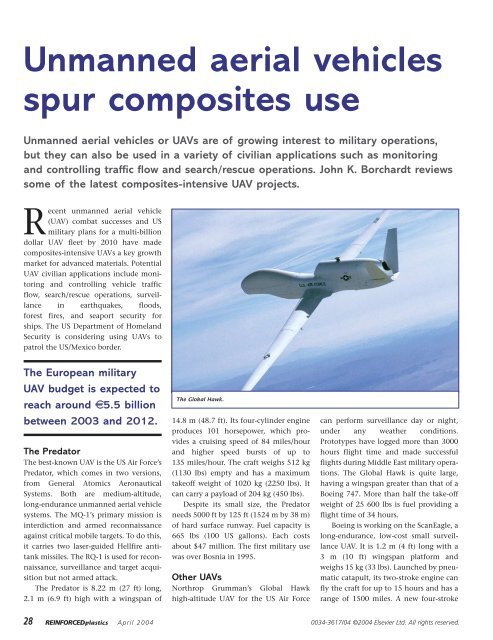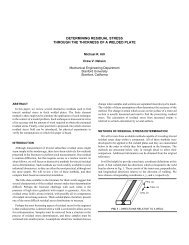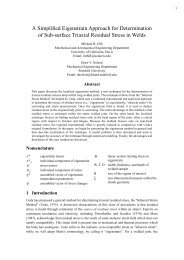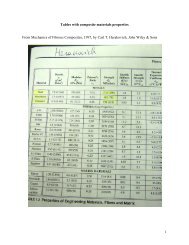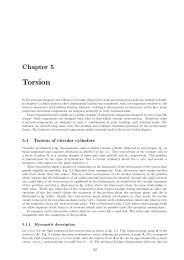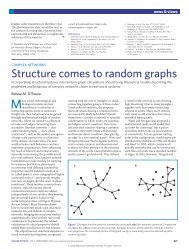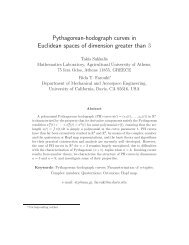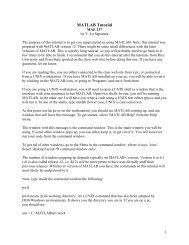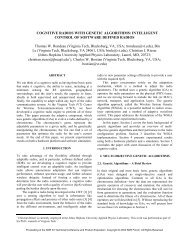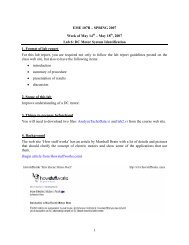Unmanned aerial vehicles spur composites use
Unmanned aerial vehicles spur composites use
Unmanned aerial vehicles spur composites use
Create successful ePaper yourself
Turn your PDF publications into a flip-book with our unique Google optimized e-Paper software.
<strong>Unmanned</strong> <strong>aerial</strong> <strong>vehicles</strong><br />
<strong>spur</strong> <strong>composites</strong> <strong>use</strong><br />
<strong>Unmanned</strong> <strong>aerial</strong> <strong>vehicles</strong> or UAVs are of growing interest to military operations,<br />
but they can also be <strong>use</strong>d in a variety of civilian applications such as monitoring<br />
and controlling traffic flow and search/rescue operations. John K. Borchardt reviews<br />
some of the latest <strong>composites</strong>-intensive UAV projects.<br />
Recent unmanned <strong>aerial</strong> vehicle<br />
(UAV) combat successes and US<br />
military plans for a multi-billion<br />
dollar UAV fleet by 2010 have made<br />
<strong>composites</strong>-intensive UAVs a key growth<br />
market for advanced materials. Potential<br />
UAV civilian applications include monitoring<br />
and controlling vehicle traffic<br />
flow, search/rescue operations, surveillance<br />
in earthquakes, floods,<br />
forest fires, and seaport security for<br />
ships. The US Department of Homeland<br />
Security is considering using UAVs to<br />
patrol the US/Mexico border.<br />
The European military<br />
UAV budget is expected to<br />
reach around 5.5 billion<br />
between 2003 and 2012.<br />
The Predator<br />
The best-known UAV is the US Air Force’s<br />
Predator, which comes in two versions,<br />
from General Atomics Aeronautical<br />
Systems. Both are medium-altitude,<br />
long-endurance unmanned <strong>aerial</strong> vehicle<br />
systems. The MQ-1’s primary mission is<br />
interdiction and armed reconnaissance<br />
against critical mobile targets. To do this,<br />
it carries two laser-guided Hellfire antitank<br />
missiles. The RQ-1 is <strong>use</strong>d for reconnaissance,<br />
surveillance and target acquisition<br />
but not armed attack.<br />
The Predator is 8.22 m (27 ft) long,<br />
2.1 m (6.9 ft) high with a wingspan of<br />
28 REINFORCEDplastics April 2004<br />
The Global Hawk.<br />
14.8 m (48.7 ft). Its four-cylinder engine<br />
produces 101 horsepower, which provides<br />
a cruising speed of 84 miles/hour<br />
and higher speed bursts of up to<br />
135 miles/hour. The craft weighs 512 kg<br />
(1130 lbs) empty and has a maximum<br />
takeoff weight of 1020 kg (2250 lbs). It<br />
can carry a payload of 204 kg (450 lbs).<br />
Despite its small size, the Predator<br />
needs 5000 ft by 125 ft (1524 m by 38 m)<br />
of hard surface runway. Fuel capacity is<br />
665 lbs (100 US gallons). Each costs<br />
about $47 million. The first military <strong>use</strong><br />
was over Bosnia in 1995.<br />
Other UAVs<br />
Northrop Grumman’s Global Hawk<br />
high-altitude UAV for the US Air Force<br />
can perform surveillance day or night,<br />
under any weather conditions.<br />
Prototypes have logged more than 3000<br />
hours flight time and made successful<br />
flights during Middle East military operations.<br />
The Global Hawk is quite large,<br />
having a wingspan greater than that of a<br />
Boeing 747. More than half the take-off<br />
weight of 25 600 lbs is fuel providing a<br />
flight time of 34 hours.<br />
Boeing is working on the ScanEagle, a<br />
long-endurance, low-cost small surveillance<br />
UAV. It is 1.2 m (4 ft) long with a<br />
3 m (10 ft) wingspan platform and<br />
weighs 15 kg (33 lbs). Launched by pneumatic<br />
catapult, its two-stroke engine can<br />
fly the craft for up to 15 hours and has a<br />
range of 1500 miles. A new four-stroke<br />
0034-3617/04 ©2004 Elsevier Ltd. All rights reserved.
engine extends flight time to 60 hours<br />
and the range to 5000 miles.<br />
Northrop Grumman’s Fire Scout vertical<br />
takeoff and landing tactical unmanned<br />
helicopter is being developed<br />
for the US Navy. The US Coast Guard has<br />
selected Bell Helicopter Textron’s Eagle<br />
Eye unmanned tilt-rotor craft, a direct<br />
competitor to the Fire Scout, for surveillance<br />
duties. The Eagle Eye has a<br />
wingspan of 7.2 m (23.6 ft) and a length<br />
of 5.2 m (17 ft).<br />
France has purchased the Predator<br />
and calls it the Horus. Both France and<br />
Germany <strong>use</strong>d UAVs over Bosnia for<br />
reconnaissance. They have jointly funded<br />
development of the Brevel. The UK’s<br />
Phoenix has served in Kosovo and<br />
mounts a mission pod under the<br />
f<strong>use</strong>lage.<br />
Some of the leading UAV manufacturers<br />
such as Elbit, IAI, Sagem SA, EADS<br />
and Dassault Aviation are located in<br />
France, Germany and Israel. The<br />
European military UAV budget is expected<br />
to reach around 5.5 billion between<br />
2003 and 2012. Besides military <strong>use</strong>s, the<br />
growing focus on homeland security is<br />
an important revenue driver, as the<br />
European Union expands and new<br />
reconnaissance needs emerge.<br />
Beyond reconnaissance<br />
Some UAV proponents believe that the<br />
current fighter planes under development<br />
will be the last to <strong>use</strong> human<br />
pilots. They claim that pilot limitations<br />
due to the gravity forces they can endure<br />
without losing consciousness (about<br />
9-Gs) and other factors make unmanned<br />
combat <strong>aerial</strong> <strong>vehicles</strong> (UCAVs)<br />
inevitable. While UCAVs are under<br />
development, it remains to be seen if<br />
they will join UAVs in military <strong>use</strong>.<br />
Beca<strong>use</strong> of their small size and lack of<br />
pilot interfaces and training requirements,<br />
UCAVs are projected to cost up to<br />
65% less to produce than future manned<br />
fighter aircraft and up to 75% less to<br />
operate and maintain than current fighters.<br />
Boeing’s X-45A UCAV demonstrator<br />
air vehicle has a tail-less 26.3 ft-long airframe<br />
with a 33.8 ft wingspan. Vehicle<br />
weight is 8000 lbs (empty) and it can<br />
carry a 3000 lb payload. The demonstrator’s<br />
f<strong>use</strong>lage length is 32 ft and the<br />
wingspan is 47 ft. The X-45B operational<br />
UCAV will be slightly larger, incorporate<br />
stealth technologies and carry precision<br />
guided missiles and bombs.<br />
<strong>Unmanned</strong> combat <strong>aerial</strong><br />
<strong>vehicles</strong> are projected<br />
to cost up to 65% less<br />
to produce than future<br />
manned fighter aircraft.<br />
Northrop Grumman’s UCAV candidate is<br />
the X-47B Pegasus intended for flight<br />
operations from an aircraft carrier. The<br />
UCAV measures 27.9 ft long with a<br />
wingspan of 27.8 ft. Its operational<br />
radius is 1300 miles. Shaped like a kite,<br />
Pegasus is built largely with composite<br />
materials.<br />
Materials<br />
UAVs are no longer simple and inexpensive.<br />
Use of lightweight advanced <strong>composites</strong><br />
is essential in increasing UAV<br />
flight time. Lear Astronics Corp<br />
Development Sciences Centre’s composite<br />
capabilities for the design and fabrication<br />
of UAVs include high molecular<br />
weight polyethylene, S-glass (magnesiaalumina-silicate<br />
glass with high tensile<br />
strength), high electrical resistivity glass<br />
<strong>Unmanned</strong> <strong>aerial</strong> <strong>vehicles</strong> <strong>spur</strong> <strong>composites</strong> <strong>use</strong><br />
The US Air Force’s Predator. (Picture courtesy of<br />
US Air Force.)<br />
(E-glass), aramid, quartz, bismaleimide<br />
and graphite fibres reinforcing epoxy,<br />
polyester, vinyl ester, phenolic, and polyimide<br />
resins. Composite processing<br />
methods include compression moulding,<br />
resin transfer moulding (RTM), prepreg<br />
lay-up, wet lay-up and convolute winding<br />
with oven or autoclave curing.<br />
These advantages of <strong>composites</strong> over<br />
metals are important in UAVs:<br />
· low weight;<br />
· excellent corrosion resistance;<br />
· high resistance to fatigue;<br />
· reduced machining;<br />
· the ability to fabricate tapered sections<br />
and intricate contoured parts;<br />
· the ability to orient reinforcement<br />
fibres in the direction of maximum<br />
stiffness and strength;<br />
· the reduced number of assemblies<br />
and fasteners needed when using cocure<br />
or co-consolidation composite<br />
manufacturing processes;<br />
Boeing’s X-45 A unmanned combat <strong>aerial</strong> vehicle is intended to replace conventionally piloted fighter<br />
planes. This is the ‘first generation’ demonstration version of the aircraft. (Picture courtesy of Boeing<br />
Corp.)<br />
April 2004 REINFORCEDplastics<br />
29
<strong>Unmanned</strong> <strong>aerial</strong> <strong>vehicles</strong> <strong>spur</strong> <strong>composites</strong> <strong>use</strong><br />
The Franco-German Brevel UAV is<br />
manufactured by GIE Eurodrone. The dark<br />
circle on the nose is the location of the<br />
reconnaissance instrument package. (Picture<br />
courtesy of GIE Eurodrone.)<br />
· low radar and microwave absorption<br />
of <strong>composites</strong>, which provides<br />
‘stealth’ capabilities making radar<br />
detection difficult; and<br />
· a very low thermal expansion reducing<br />
operational problems in high altitude<br />
flight.<br />
However, <strong>composites</strong> also have disadvantages<br />
compared to metals:<br />
· higher cost;<br />
· relative lack of established design criteria;<br />
· degradation of structural properties at<br />
high temperature or when wet;<br />
· poor energy absorption and resulting<br />
impact damage in hard landings;<br />
· the need for lightening strike protection;<br />
· corrosion problems due to poor or<br />
incomplete adhesion to metals particularly<br />
when using carbon or<br />
graphite materials;<br />
· reliable detection of substandard<br />
composite-metal bonds is difficult;<br />
· the location of these sub-standard<br />
bond locations is often imprecise;<br />
and<br />
· the expensive and complicated<br />
inspection procedures needed.<br />
For weight reasons, aluminium is the<br />
only metal <strong>use</strong>d in UAVs. Use of <strong>composites</strong><br />
can reduce overall UAV weight by<br />
15-45% depending on the extent of composite<br />
<strong>use</strong>. Above a 50% weight reduction<br />
requires improvements in<br />
composite economics at the moment.<br />
30 REINFORCEDplastics April 2004<br />
Composites have been <strong>use</strong>d in modest<br />
load-bearing components such as elevators,<br />
which comprise about 20% of aircraft<br />
weight. For further weight reduction,<br />
<strong>composites</strong> must be <strong>use</strong>d in higher<br />
load-bearing components such as the<br />
tail, wing and f<strong>use</strong>lage.<br />
Thermosets are <strong>use</strong>d more than<br />
thermoplastics beca<strong>use</strong> the resin readily<br />
impregnates fibres, making it possible to<br />
manufacture complex shaped parts.<br />
Thermosets provide high strength and<br />
high stiffness parts after curing. Epoxies<br />
are the most commonly <strong>use</strong>d thermosets<br />
in UAVs. They provide good low-temperature<br />
(95% carbon) and carbon (93-<br />
95% carbon) fibres are the most commonly<br />
<strong>use</strong>d. Other organic polymers<br />
such as Kevlar are also <strong>use</strong>d. Glass fibre is<br />
<strong>use</strong>d occasionally for its low cost and is<br />
likely to be more common in civilian<br />
than military UAVs due to the former’s<br />
less rigorous operating conditions.<br />
Typical damage to <strong>composites</strong> that<br />
needs to be detected both after fabrication<br />
and after UAV flight are: cracks and<br />
delaminations in the skin; debondings<br />
between skin and core; and defects in the<br />
core (crushing), of which only a small<br />
part is visible from the outside.<br />
Ultrasonic detection can indicate internal<br />
defects. Detection of damage is<br />
essential to proper UAV maintenance<br />
and long service life.<br />
Specific UAVs<br />
Early UAVs and most prototypes for civilian<br />
applications <strong>use</strong> a simple, fixed-pitch<br />
wooden propeller protected with a
varnish finish. Wood has a high fatigue<br />
strength-to-weight ratio, low material<br />
cost and excellent vibration damping<br />
properties. It also has a low radar signature<br />
making combat reconnaissance<br />
harder to detect.<br />
For larger UAVs, operating conditions<br />
often require more propeller<br />
strength and durability than wood can<br />
provide. One solution to this problem is<br />
the <strong>use</strong> of synthetic fibre reinforcement<br />
over a laminated wood core. Kevlar and<br />
glass fibres with epoxy resin have been<br />
<strong>use</strong>d for this, but using carbon semistressed<br />
fibre-reinforced epoxy resin over<br />
laminated wood has become more common.<br />
This construction optimizes airfoils<br />
and blade shape to provide rapid<br />
climb, while maintaining level flight<br />
performance, good damage tolerance<br />
and long service life.<br />
Completely synthetic composite propellers<br />
are beginning to be <strong>use</strong>d beca<strong>use</strong><br />
they provide both high performance and<br />
durability. These are typically comprised<br />
of carbon/glass fabric impregnated with<br />
high-temperature epoxy resin. Their<br />
pitch may be adjusted before takeoff to<br />
provide flexibility for operating in different<br />
weather conditions.<br />
Propellers must be resistant to rain<br />
erosion; a resistance varnished wood<br />
propellers lack. Urethane tapes applied<br />
to the propeller leading edges provide a<br />
short-term, replaceable solution to<br />
this problem while inlaid urethane<br />
resin edges provide increased durability<br />
and improved aerodynamics. Urethane<br />
and epoxy resins may also be applied<br />
to the entire propeller. Recently, bonded<br />
nickel erosion shields have been<br />
<strong>use</strong>d with all-composite propeller<br />
blades.<br />
The University of Sydney’s UAV<br />
Brumby was developed for flight<br />
research. The main gear of the undercarriage<br />
is a carbon fibre/Kevlar fibre<br />
composite. The f<strong>use</strong>lage is constructed<br />
with a sandwich composite of glass<br />
fibre/Nomex resin, which provides a<br />
lightweight, stiff, strong structure.<br />
Originally the wings were foam cores<br />
covered with plywood and glass fibre<br />
but are now a composite of<br />
glass/Nomex resin<br />
Early prototype versions of the<br />
ScanEagle were made largely of aluminium<br />
and composite, but the newer versions<br />
are constructed of lighter-weight<br />
carbon fibre <strong>composites</strong>. While the<br />
Global Hawk’s f<strong>use</strong>lage is mostly aluminium,<br />
some components are <strong>composites</strong>,<br />
as are the tail assembly and engine<br />
nacelles. Its long wings are built around<br />
four I-beam carbon/epoxy spars. The<br />
wing leading and trailing edges are<br />
Nomex ® aramid honeycomb-cored<br />
sandwich laminates.<br />
Other nations developing UAVs also<br />
rely extensively on <strong>composites</strong> for UAV<br />
construction. For example, Israel’s Orlite<br />
<strong>use</strong>s glass, aramid, graphite, reinforced<br />
polyester, epoxy and phenolic resins in<br />
its UAVs. According to the Aeronautical<br />
Development Establish-ment of the<br />
Indian Ministry of Defence, its UAV has a<br />
laminated glass/carbon-reinforced fibre<br />
airframe.<br />
The first versions of Boeing’s X-45A<br />
UCAV had an internal aluminium structure<br />
with a low-radar-profile carbon<br />
composite being <strong>use</strong>d for the eternal<br />
skin. Production aircraft are likely to be<br />
of an all-composite construction. The<br />
wing is built around a lightweight foam<br />
matrix core.<br />
To accommodate the high mechanical<br />
stresses and thermal loads<br />
associated with maneuvering UCAVs at<br />
high speed (Mach 12-15), <strong>use</strong> of metal<br />
matrix <strong>composites</strong> and ceramic/metal<br />
<strong>composites</strong> is likely to become<br />
common.<br />
<strong>Unmanned</strong> <strong>aerial</strong> <strong>vehicles</strong> <strong>spur</strong> <strong>composites</strong> <strong>use</strong><br />
AAI Corp’s Shadow can carry a payload of 50 lbs, which is considerably less than some existing small<br />
UAVs can carry. However, it can carry the


